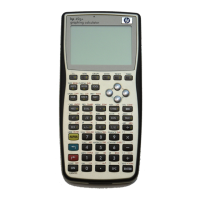
Do you have a question about the HP 49g+ and is the answer not in the manual?
| Display Type | LCD |
|---|---|
| Display Size | 131 x 80 pixels |
| Power | 4 AAA batteries |
| Type | Graphing calculator |
| Programming | RPL, System RPL |
| Dimensions | 18.7 x 8.7 x 3.9 cm (7.4 x 3.4 x 1.5 in) |
| Weight | 215 g |
Guide to setting operating modes, number formats, angle measures, and coordinate systems.
Details on Algebraic and RPN operating modes with examples.
Adjusting Computer Algebraic System (CAS) settings for symbolic operations.
Associating units with numbers and performing calculations with consistent units.
Creating and implementing user-defined functions using the DEFINE command.
Activating the COMPLEX mode within the CAS settings for complex number operations.
Solving algebraic equations symbolically using ISOL, SOLVE, and ZEROS functions.
Accessing the numerical solver for single algebraic or transcendental equations.
Solving linear, non-linear, algebraic, and transcendental equations via NUM.SLV.
Solving systems of simultaneous equations using the MSLV function.
Performing arithmetic operations, sign changes, and concatenation on lists.
Performing basic vector operations like sign change, addition, subtraction, and scalar multiplication.
Performing addition, subtraction, scalar multiplication, and matrix multiplication.
Methods for solving systems of linear equations using numerical solvers.
Steps for plotting functions in the form y = f(x).
Using functions like lim, DERIV, and DERVX for calculus operations.
Calculating integrals and anti-derivatives using INT, INTVX, RISCH, SIGMA functions.
Calculating partial derivatives of multi-variable functions.
Computing double and other multiple integrals.
Solving linear ordinary differential equations with constant coefficients.
Solving various types of differential equations using the DESOLVE function.
Calculating factorials, permutations (PERM), and combinations (COMB).
Inputting data into the ΣDAT matrix using the matrix writer.
Computing statistics like mean, standard deviation, variance, min, max for a data set.
Fitting linear, logarithmic, exponential, or power functions to data sets.
Calculating confidence intervals for population means, proportions, and differences.
Performing hypothesis tests for population parameters (mean, proportion).
Accessing the BASE menu for conversions between decimal, binary, octal, and hexadecimal.
Saving calculator objects (programs, data) to an SD card.
Retrieving calculator objects from an SD card.
Deleting calculator objects from an SD card.